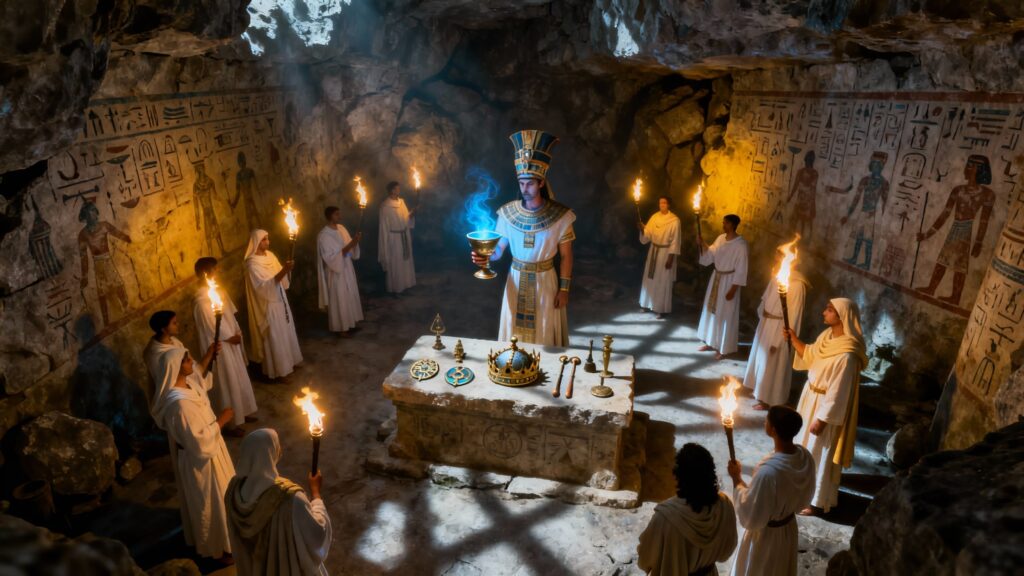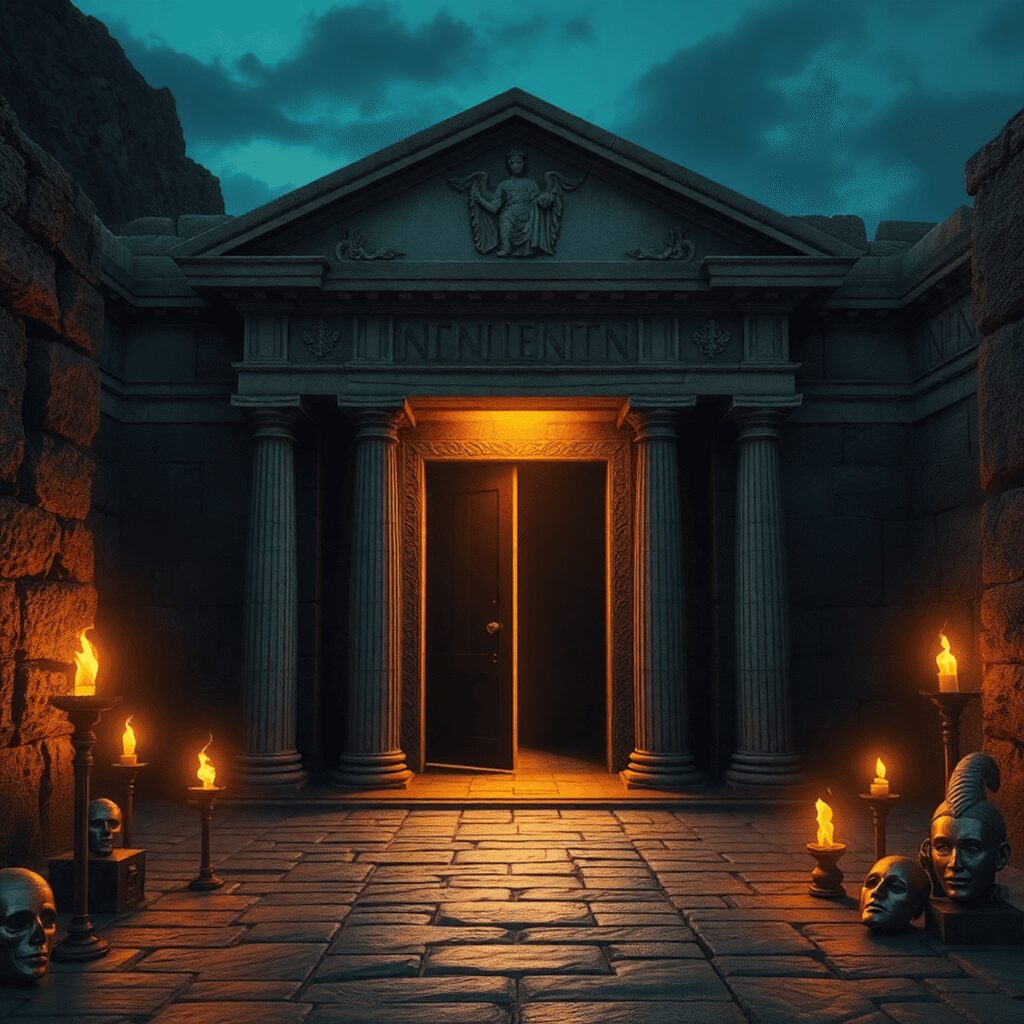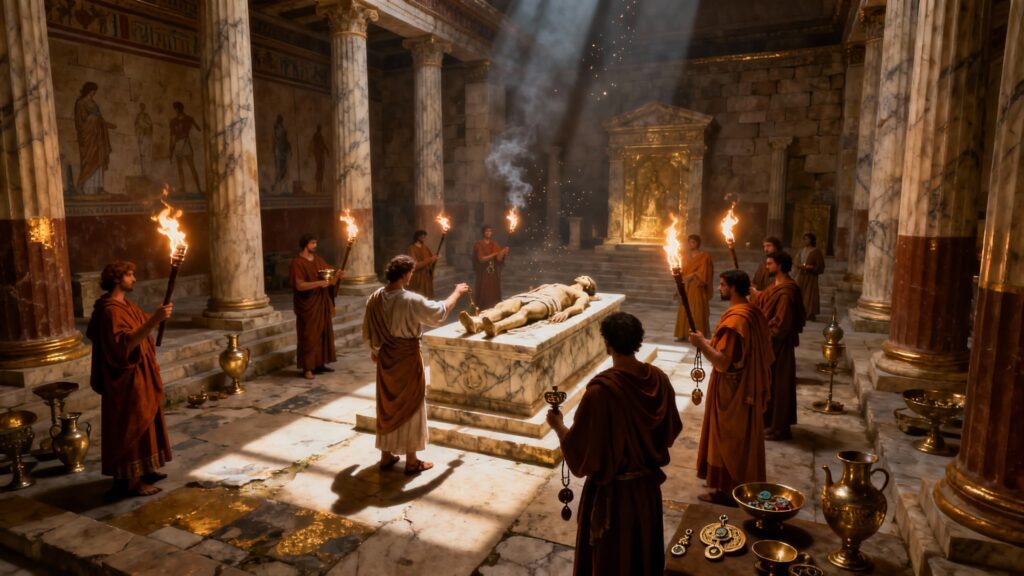Rome’s mystery cults were secretive religious groups that thrived in the ancient Mediterranean world. These cults stood apart from public religions by focusing on exclusive initiations, secret rituals, and promises of personal transformation. Central to their practices were themes of death and rebirth, reflecting deep spiritual journeys and the cycles of nature. Examples include the Eleusinian Mysteries, the Dionysian rites, and the Mithraic cult—all emphasizing inner knowledge over public worship.
Secret societies remain significant today, often shrouded in secrecy and ritual. They attract individuals seeking connection, purpose, or enlightenment through structured ceremonies and exclusive membership. From fraternal orders to esoteric organizations, these groups carry forward traditions of secrecy and initiation that echo ancient practices.
This article explores how Rome’s mystery cults influenced modern secret societies worldwide. It examines key characteristics of these ancient religions and identifies their enduring impact on contemporary groups. Understanding this connection reveals not only historical continuity but also how cultural influence from Rome’s diverse religious landscape shaped the foundations of many secretive organizations existing today.
In addition to these spiritual influences, it’s important to acknowledge that Ancient Rome’s impact extends beyond religion into areas such as law, economy, and even propaganda. For instance, Roman law has significantly shaped modern legal systems, providing a legal framework that many countries still follow today. The trade and economic practices of Ancient Rome were foundational to its vast empire, influencing both daily life and long-term stability.
Moreover, coins in Ancient Rome served not just as currency but also as powerful tools for political messaging, acting as propaganda to convey authority and legitimacy. These aspects of Roman influence highlight a broader cultural legacy that continues to resonate in various facets of modern society.
Understanding Rome’s Mystery Cults
Rome’s mystery cults, also known as Greco-Roman mystery religions, distinguished themselves from traditional public worship through their secret rituals and deeply personal spiritual experiences. These cults promised personal salvation and transformation, which was achieved through participation in exclusive initiation rites. Their practices were shrouded in secrecy, with knowledge and ceremonies revealed only to initiated members.
Characteristics of Mystery Cults
Mystery cults revolved around several distinctive features that set them apart:
- Purification Rites: Initiates underwent rigorous purification processes before entering the inner sanctums of the cult. This cleansing was both physical and spiritual, symbolizing the shedding of past impurities to prepare for rebirth or enlightenment.
- Ritual Drama: Central to these cults were reenactments of mythological narratives often involving death and rebirth. These ritual dramas allowed participants to symbolically experience the transformative journeys of gods or heroes, reinforcing themes of renewal and salvation.
- Symbolic Objects: Sacred objects held great significance within mystery religions. Items such as torches, sacred vessels, or symbolic tokens were used during ceremonies to convey hidden meanings understood only by initiates.
- Sacred Feasts: Communal meals formed an essential part of the religious experience. These feasts were not merely social gatherings but sacred acts that reinforced communal bonds and spiritual unity among members.
- Hierarchical Initiation Grades: Membership was structured through progressive stages. Initiates advanced through multiple levels of initiation, each granting access to deeper esoteric teachings and secret knowledge. This hierarchy created a sense of exclusivity and personal growth within the cult.
The Role of Purification and Ritual Drama
Purification rites served as gateways into the mystery cults’ secret knowledge. Water, fire, fasting, or ritual baths might be involved in cleansing ceremonies designed to prepare the initiate for spiritual revelation. The process signified leaving behind worldly attachments and entering a sacred space of transformation.
Ritual drama acted as a living myth for members. By participating in these dramatizations—such as those depicting Persephone’s descent into Hades or Mithras slaying the cosmic bull—initiates emotionally connected with powerful archetypes. This immersion fostered a profound internal change aligned with the cult’s promise of salvation.
Use of Symbolic Objects and Sacred Feasts
Objects used in mystery rites carried layers of meaning beyond their physical form. For example:
- Torches symbolized light overcoming darkness.
- Sacred vessels represented divine receptacles containing mystical substances.
- Tokens or amulets functioned as protective charms or signs of membership.
Sacred feasts reinforced spiritual communion among initiates. Sharing food and drink was an enactment of unity with divine forces and fellow members, mirroring cosmic cycles celebrated by these religions.
Structure of Hierarchical Initiation Grades
Progression through initiation grades was fundamental in maintaining order within the cults. Each level introduced new teachings, rituals, and responsibilities:
- Preliminary Initiation: Basic entry involving initial purification.
- Intermediate Levels: Deeper engagement with symbolic rites and secret teachings.
- Advanced Grades: Access to highest mysteries, often reserved for elite members who had demonstrated commitment.
This tiered system encouraged dedication by offering personal advancement tied directly to increased spiritual insight.
The combination of purification rites, ritual drama, symbolic artifacts, sacred communal acts, and graded initiation formed an integrated religious experience unique to Greco-Roman mystery religions. These elements created an environment where secrecy was maintained not only by oath but by layered complexity accessible only through gradual initiation.
Cultural and Religious Syncretism in Mystery Cults
Rome’s mystery cults thrived within a vibrant multicultural religious environment that actively absorbed and adapted foreign deities and traditions. This syncretism became a defining trait of these secretive groups, enriching their secret rituals and initiation rites with diverse spiritual elements.
Key examples include:
Isis Worship: Originating from Egypt, the goddess Isis was embraced by Roman initiates drawn to her associations with magic, healing, and protection. Her cult introduced new mythologies and symbolic objects into the Greco-Roman mystery religions, emphasizing personal salvation through devotion and secret ceremonies.
Mithras Cult: Mithraism, rooted in Persian beliefs, gained popularity among Roman soldiers and officials. Its complex hierarchy of hierarchical initiation grades, ritual dramas reenacting cosmic battles, and sacred feasts mirrored indigenous practices but carried distinct theological themes of light triumphing over darkness.
The blending of these traditions reflected Rome’s openness to foreign influences amid its expansive empire. The exchange of religious ideas enhanced the allure of mystery cults by promising spiritual transformation through exclusive knowledge and ritual experience. This fusion created a rich tapestry that shaped the nature of secrecy, symbolism, and social bonding in ancient Roman religious life.
Such cultural integration set a precedent for later secret societies worldwide, which continue to draw upon this heritage of combining diverse esoteric traditions within exclusive communities. The rituals and sacrifices performed during these mystery cults were deeply connected to the divine. These practices not only emphasized maintaining good relationships with the gods but also showcased the Romans’ belief in many deities influenced by earlier cultures like the Greeks and Etruscans.
Moreover, the artistic expressions that emerged from this confluence of various cultures reflect not only the aesthetic values of its time but also the social, political, and cultural dynamics that shaped the Roman world. The Roman military’s power and strategy further facilitated this cultural integration by spreading these mystery cults across vast territories.
Lastly, the evolution of Roman sculpture, which significantly focused on realism and portrayal of power, also played a role in reflecting the cultural dynamics during this period.

Core Elements of Mystery Cults That Resonate in Modern Secret Societies
Secrecy and Oaths in Modern Secret Societies
Secret rituals and initiation practices were the foundation of Rome’s mystery cults. These elements have been preserved and transformed within contemporary secret societies, shaping their sense of exclusivity and identity.
The Importance of Secrecy and Oaths
The concept of ritual secrecy is still very important. Members are bound by oaths of silence, pledging never to reveal the inner workings or sacred knowledge of their order. This solemn vow creates a powerful boundary between initiates and outsiders, reinforcing trust and loyalty within the group.
The importance of secrecy oaths cannot be overstated. They serve as both a protective mechanism for the group’s esoteric wisdom and a rite of passage for new members. Taking such an oath symbolizes a profound commitment to the society’s values, often accompanied by solemn ceremonies that echo ancient traditions.
Symbols and Handshakes: Tools of Recognition
Identification within these groups goes beyond verbal promises. The use of coded symbols plays a critical role in maintaining secrecy while providing discreet means of recognition among members. These symbols might appear in artwork, jewelry, or documents tied to the society, carrying layered meanings accessible only to those initiated. The hidden language established through these symbols preserves continuity with ancient practices where sacred objects conveyed spiritual truths.
Another hallmark is the employment of secret handshakes or gestures—physical signs that function as silent passwords. These handshakes are often complex, passed down through generations to ensure that only true members can gain entry into meetings or rituals. Such nonverbal communication reflects the emphasis on subtlety and discretion found in Roman mystery cults.
Creating Community through Secrecy
These aspects create an atmosphere where personal transformation coincides with communal belonging, just as in ancient mystery religions. The shared experience of safeguarding secrets fosters a unique social bond, mirroring how Roman cults combined spirituality with tight-knit fellowship.
This framework of secrecy and symbolic communication remains one of the strongest links connecting Rome’s mystery cult heritage to today’s secret societies worldwide.

Hierarchical Structure and Initiation Stages in Contemporary Organizations
Rome’s mystery cults laid the groundwork for tiered membership systems found in many modern secret societies. These ancient groups had different initiation grades, each allowing entry into deeper levels of hidden knowledge and ritual secrecy. Moving through these stages wasn’t just a formality; it represented a significant spiritual or personal change.
Organizations like Freemasonry still follow this model with clearly defined degrees or levels. Members progress by participating in specific ceremonies, understanding symbolic language, and using coded symbols that are unique to their position. This creates an exclusive space where knowledge is closely protected and only shared with those who have demonstrated their dedication.
The focus on ritual reenactments and the gradual revealing of secrets promotes a strong feeling of belonging and purpose. New members are looking for more than just social interaction; they are seeking self-discovery and enlightenment within a structure that reflects the hierarchical, secretive nature of Rome’s mystery cults.
Influence on Specific Modern Secret Societies: The Case of Freemasonry
Freemasonry’s origins trace back to a complex blend of medieval stonemason guilds and older esoteric traditions, with clear lines of influence from Rome’s mystery cults. These cults provided a blueprint for secretive rituals, hierarchical progressions, and symbolic language that became cornerstones of Freemasonry’s identity.
Key parallels between Freemasonry and Roman mystery cults include:
Ritual Drama and Initiation: Much like the mystery religions’ use of ritual reenactments symbolizing death and rebirth, Freemasonry employs staged ceremonies that mark a candidate’s progression through degrees. Each degree conveys moral lessons often veiled in allegory, echoing the transformative experiences promised by ancient mysteries.
Symbolism: Both systems rely heavily on symbolic objects—Roman cults used items like torches, crowns, or sacred vessels; Freemasonry incorporates tools such as the compass, square, and trowel. These symbols function as teaching aids and markers of membership identity.
Secrecy and Oaths: The requirement of strict secrecy surrounding rituals and knowledge is essential in both traditions. Oaths taken by initiates bind members to discretion and loyalty, fostering exclusivity.
Hierarchical Grades: The tiered structure in mystery cults finds its counterpart in Masonic degrees (Entered Apprentice, Fellowcraft, Master Mason), each conferring deeper esoteric understanding and social standing within the lodge.
The influence of the Roman Pantheon, which includes gods associated with power, justice, and wisdom, can also be seen within these practices. This pantheon reflects the values, beliefs, and customs that influenced the lives of its people and adds another layer to understanding the connection between these ancient practices and modern secret societies.
Freemasonry’s influence extends beyond its own lodges into various fraternal organizations worldwide. Groups such as the Odd Fellows or Elks have adopted similar frameworks—ritual drama, secret signs, initiation rites—that reflect the enduring legacy of Rome’s mystery cults. This diffusion highlights how ancient religious practices continue shaping contemporary social bonds through shared secrecy and symbolism within fraternal orders.

Other Secret Societies with Roots in Mystery Cult Traditions: A Brief Overview
Several secret societies beyond Freemasonry trace their origins or inspiration to the ancient mystery cults of Rome. Two notable examples are the Rosicrucians and the Knights Templar, both of which exhibit clear influences from these early esoteric traditions.
Rosicrucians Influences
This mystical order emerged during the early 17th century and claims a lineage that echoes the secrecy and symbolic knowledge of Roman mystery religions. Rosicrucian teachings emphasize alchemical transformation, spiritual enlightenment, and hidden wisdom, much like the personal salvation promised by ancient cults. Their rituals incorporate symbolic objects, coded language, and initiation ceremonies that reflect the hierarchical progression familiar to mystery cult initiates.
Knights Templar
Though primarily a medieval military order, the Templars adopted ritualistic practices and secretive elements that may have been inspired by earlier esoteric groups. Their structure included ranks, oaths, and sacred rites designed to bind members within a strong communal identity—key traits inherited from mystery cult traditions.
Common themes across these groups include:
- Secrecy: Oaths of silence protect inner mysteries from outsiders.
- Ritual Drama: Reenactments of mythic or allegorical stories serve to teach moral or spiritual lessons.
- Initiatory Progression: Members advance through levels or degrees, gaining deeper knowledge and responsibilities.
The persistence of these elements highlights how ancient mystery cults provided a foundational blueprint for secretive organizations seeking to blend spirituality with social cohesion.
Legacy and Cultural Influence of Rome’s Mystery Cults Today
Rome’s mystery cults had a significant impact on Western esotericism and secret societies. Their influence goes beyond just religious beliefs, affecting ritual practices, symbols, and the structure of exclusive groups that value inner knowledge and personal growth.
The Role of Mystery Cults in Shaping Communities
These cults combined spiritual beliefs with social functions, creating communities where individual spiritual experiences were closely tied to group identity. Initiation ceremonies and secret rituals strengthened members’ sense of belonging and loyalty, leading them to form tight-knit networks connected by shared secrets. This integration of sacred rituals and social bonding set a precedent for future organizations aiming to foster both spiritual wisdom and communal exclusivity.
Direct Descendants of Ancient Practices
Aspects like hierarchical initiation levels, symbolic language, and coded rituals can be directly traced back to these ancient customs. Present-day secret societies adopt these elements not only for their mysterious allure but also because they offer frameworks for personal development within a nurturing social environment. The legacy of Rome’s mystery cults shows how spiritual teachings can be integrated into community life, impacting numerous generations around the world.
Understanding the Influence of Rome’s Mystery Cults
This blending of religious mysticism and social unity is key to understanding how Rome’s Mystery Cults Influenced Modern Secret Societies Worldwide. The origins of this influence can be found in the complex societal systems created by the Romans, which have laid the foundation for many aspects of contemporary life, including legal frameworks and architectural wonders.
However, it’s crucial to recognize that the decline of these powerful structures wasn’t solely caused by outside invasions; it was also significantly affected by political instability and weak leadership. This highlights the intricate relationship between governance and societal stability in shaping civilizations.
Conclusion
The influence of Rome’s mystery cults on modern secret societies worldwide is undeniable. Their combination of secrecy, ritual, and hierarchical initiation continues to fascinate contemporary organizations, providing a framework for exclusivity and spiritual transformation. These ancient traditions highlight the human desire for belonging, mystery, and deeper knowledge.
Consider these key reflections:
- Secrecy and ritual create powerful bonds that transcend time.
- Initiation stages symbolize personal growth and transformation.
- Symbolic language fosters a shared identity among members.
Your curiosity about How Rome’s Mystery Cults Influenced Modern Secret Societies Worldwide invites you to delve deeper into this fascinating subject. Exploring these roots enriches your understanding of today’s esoteric communities and their enduring legacy.
Engage with history. Question the mysteries. Discover the hidden connections that shape secret societies around the globe.
FAQs (Frequently Asked Questions)
What were the main characteristics of Rome’s mystery cults?
Rome’s mystery cults were defined by secret ceremonies, purification rites, symbolic objects, and hierarchical initiation grades. They emphasized ritual drama, personal salvation, and exclusive initiations that promised transformation to their members.
How did Rome’s multicultural environment influence its mystery religions?
Rome’s multicultural context led to religious syncretism where deities like the Egyptian Isis and Persian Mithras were incorporated into Roman mystery religions, enriching their practices and symbolism within a diverse religious landscape.
In what ways do modern secret societies reflect elements of ancient Roman mystery cults?
Modern secret societies retain core elements from Roman mystery cults such as ritual secrecy, initiatory practices, use of symbolic language, secrecy oaths, coded symbols, and hierarchical initiation stages that foster exclusivity and personal transformation.
How has Freemasonry been influenced by Rome’s mystery cults?
Freemasonry draws inspiration from the structures and symbolism of Roman mystery cults. Its rituals parallel those ancient practices, reflecting a broader impact on fraternal organizations worldwide through shared themes of secrecy and initiation.
Which other modern secret societies have roots in ancient mystery cult traditions?
Besides Freemasonry, groups like the Rosicrucians and Knights Templar show influences from ancient mystery cults. These societies share themes such as secrecy, ritual drama, initiatory progression, and esoteric knowledge passed through graded memberships.
What is the lasting cultural legacy of Rome’s mystery cults today?
Rome’s mystery cults have left a profound imprint on Western esotericism and secret society culture by blending religious mysticism with social cohesion. Their enduring legacy continues to inspire fascination with secrecy and ritual in contemporary organizations worldwide.

